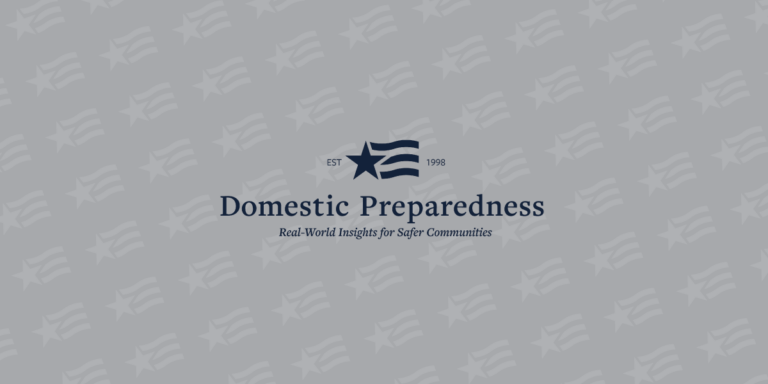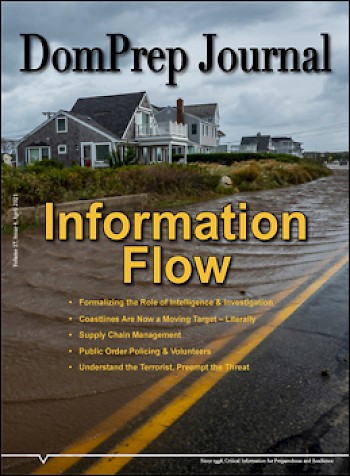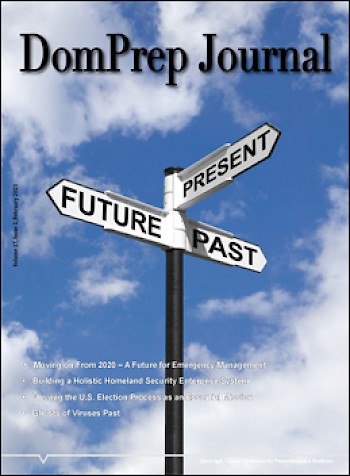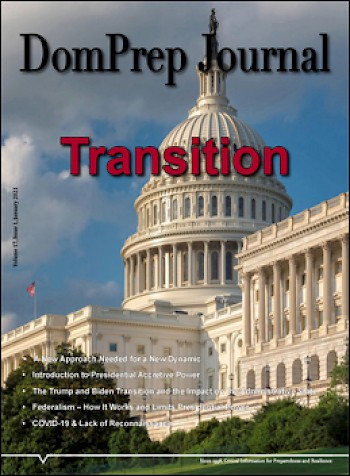
Author Archive

This report and companion documents identify relevant concepts, considerations, and principles that can inform jurisdictions in planning for evacuation and/or shelter-in-place protective actions. The research report presents recommendations for informing community members about risk and providing effective warnings. https://www.fema.gov/sites/default/files/documents/fema_improving-public-messaging-for-evacuation-and-shelter-in-place_literature-review-report.pdf

April 2021
Domestic Preparedness
April 28, 2021
Featured in this issue: Information – Keep It Flowing, By Catherine L. Feinman; Formalizing the Role of Intelligence & Investigation, By Michael Prasad ; Coastlines Are Now a Moving Target – Literally, By John Englander; Supply Chain Management Podcast, By Martin D. Masiuk; Public Order Policing & Volunteers, By Erik

Biodefense in Crisis – Immediate Action Needed to Address National Vulnerabilities
Domestic Preparedness
April 6, 2021
This Bipartisan Commission on Biodefense report closely examines the extent of progress that has been made since the Commission released its National Blueprint for Biodefense in 2015. Biodefense in Crisis provides a fresh assessment of governmental efforts to implement the Commission’s recommendations to prevent, deter, prepare for, detect, respond to, attribute, recover from, and

March 2021
Domestic Preparedness
March 31, 2021
Featured in this issue: Search for Opportunities, By Catherine L. Feinman; Embracing Resilience: At a Crossroad of Opportunity, By Deborah Weiser & Gregory Brunelle; Mitigating Wildfires – Conceptualizing Possibilities, By Senay Ozbay; Tips & Tricks for Effective Disaster Planning, By Robert J. (Bob) Roller; Technical Assistance for Healthcare System Preparedness,

Ready or Not 2021: Protecting the Public’s Health Against Diseases, Disasters, and Bioterrorism
Domestic Preparedness
March 23, 2021
The Ready or Not report series provides an annual assessment of states’ levels of readiness to respond to public health emergencies. It recommends policy actions to ensure that everyone’s health is protected during such events. This 2021 edition tiers states into three performance categories – high, middle, and low – and

Survey: Pandemic Planning 2021
Domestic Preparedness
March 10, 2021
In 2020-2021, the COVID-19 pandemic has demonstrated that a public health emergency is not solely a public health problem. A multi-discipline, multi-jurisdictional effort is needed to overcome the numerous challenges that communities face. It is not good enough to create lessons learned and best practices if no subsequent actions are

Crisis Standards of Care: Lessons From New York City Hospitals’ COVID-19 Experience: The Emergency Medicine Perspective
Domestic Preparedness
March 8, 2021
The Johns Hopkins Center for Health Security released a new report about the lessons from New York City hospitals’ emergency department experiences during the unprecedented surge of COVID-19 patients in April through June 2020. This surge was associated with extraordinary use of emergency department resources needed for severely ill patients. Many hospitals were overwhelmed and found it challenging to maintain

February 2021
Domestic Preparedness
February 24, 2021
Featured in this issue: Publisher’s Message: Costs vs. Benefits, By Martin Masiuk; Moving on From 2020 – A Future for Emergency Management, By Kyle Overly; Building a Holistic Homeland Security Enterprise System, By Daniel Rector; Viewing the U.S. Election Process as an Essential Mission, By Michael Prasad; Ghosts of Viruses

January 2021
Domestic Preparedness
January 27, 2021
Featured in this issue: Transition – Separating Power From Preparedness, By Catherine L. Feinman; Publisher’s Message: A New Approach Needed for a New Dynamic, By Martin (Marty) Masiuk; An Analysis of Presidential Accretive Power – Part 1, By William H. Austin; An Analysis of Presidential Accretive Power – Part 2,

Cybersecurity and Infrastructure Security Convergence Action Guide
Domestic Preparedness
January 21, 2021
The Cybersecurity and Infrastructure Security Convergence Action Guide describes the complex threat environment created by increasingly interconnected cyber-physical systems, and the impacts that this interconnectivity has on an organization’s cybersecurity and physical security functions. It also provides information that organizations can consider to adopt a holistic cyber-physical security approach through
Follow Us
Get Instant Access
Subscribe today to Domestic Preparedness and get real-world insights for safer communities.
ARchives
Article Out Loud – Civil Disturbance Resilience-Planning, Technology & Partnerships
May 2, 2023
A peaceful protest can quickly turn to violence, and private-sector corporations sometimes get caught in the middle. Learn how one company ensures the safety of its personnel in this 2015 article.
Article Out Loud – Hospital Security: An Age-Old Problem Becomes Increasingly Important
May 2, 2023
Some states are considering bills to better protect hospital workers from violence. Although trends show an increase in violence, this 2008 article explains how this important issue has been a longtime concern.
Article Out Loud – Eclipses Again Will Darken the Sky in 2023 and 2024
April 26, 2023
An eclipse is not just about the sky getting dark. There are many considerations for emergency planners and public safety professionals to ensure the safety of their communities. Learn the lessons from the 2017 eclipse to better prepare for the next event.
Article Out Loud – Preparedness Promoters – Assessing Marginalized Populations
April 26, 2023
Certain populations are more vulnerable when faced with disasters. By adapting a public health model, community leaders can identify common vulnerability indicators and close the gaps between emergency management plans and target population vulnerabilities.
Article Out Loud – Covenant School – Reviewing Another Tragic Shooting
April 19, 2023
The Covenant School shooting is another reminder of active shooter trends. This article reviews the chain of events from that tragic event, post-incident reviews, and what communities are and should be doing to prepare for and prevent future active shooter incidents.
Article Out Loud – Labor Trafficking – An Underreported Escalating Crisis
April 19, 2023
An Article Out Loud from the Domestic Preparedness Journal, April 19, 2023. Labor trafficking affects many more people in the U.S. than sex trafficking, but it gets much less attention. Learn what the government is doing and what else community stakeholders can do now to better protect people from this
Article Out Loud – Tapping Media for Credible Disaster Communication
April 18, 2023
Few preparations made in anticipation of a disaster pay bigger dividends than how the team communicates with the news media and the public during a disaster. This 2016 article explains why.
Article Out Loud – 45 Seconds of Danger, a Lifetime of Lessons
April 18, 2023
In 2011, a “45-second” tornado proved that just because something has never happened here doesn’t mean that it cannot happen here. A wealth of lessons learned from that day continue to prepare communities today.
Article Out Loud – The DoD Defense Coordinating Element and How It Is Certified
April 12, 2023
Besides the main mission of defending the homeland, Department of Defense capabilities also provide critical support to local, state, and federal civilian partners during major disasters. Learn how Army North’s defense coordinating element’s mission and composition ready their units to perform this additional mission when needed.
Article Out Loud – Biosafety Laboratory Issues and Failures
April 12, 2023
Biosafety labs and lab leaks continue to be an area of discussion and concern, especially in a search for the source of SARS-CoV-2. It was international, but there are domestic risks too. This article explains how.
Follow Us
Get Instant Access
Subscribe today to Domestic Preparedness and get real-world insights for safer communities.


